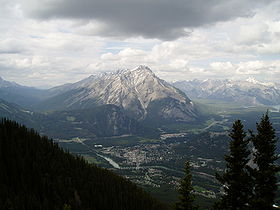Cascade Mountain (Alberta)
| Cascade Mountain | |
|---|---|

Cascade Mountain as seen from Sulphur Mountain
|
|
| Highest point | |
| Elevation | 2,998 m (9,836 ft) |
| Prominence | 938 m (3,077 ft) |
| Coordinates | 51°13′42″N 115°33′48″W / 51.22833°N 115.56333°WCoordinates: 51°13′42″N 115°33′48″W / 51.22833°N 115.56333°W |
| Geography | |
|
|
|
| Parent range | Vermillion Range |
| Topo map | NTS 82O/04 |
| Climbing | |
| First ascent | 1887 by Tom Wilson |
| Easiest route | Scramble |
Cascade Mountain is a mountain located in the Bow River Valley of Banff National Park, adjacent to the town of Banff. The mountain was named in 1858 by James Hector after the waterfall or cascade on the southern flanks of the peak. The mountain has also been called Stoney Chief, which is related to the name of the smaller neighbouring mountain Stoney Squaw, which is still in use. Cascade is the highest mountain adjacent to the townsite.
The mountain can be climbed starting from the Norquay Ski Area base. The first portion is a fairly moderate hike, up to the Cascade Amphitheatre. Continuing upwards, the route ascends along the ridge edge until it reaches the crest where it dips before it rises to the false summit. While the false summit can be descended at its end, it is much easier to follow a trail around the western side along the exposed foot. Snow typically blocks this route almost until mid July and attempting it while snowy can entail considerable avalanche risk due to the slabby terrain and exposure. A long window of clear weather - full day - should be anticipated before attempting this climb, as many climbers have gotten into trouble and needed rescue (or died) when a storm suddenly blows in. The ascent normally takes 3 to 4 hours while the descent along the same path takes 2 to 3 hours.
...
Wikipedia

